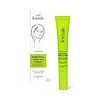What's inside
What's inside
 Key Ingredients
Key Ingredients

 Benefits
Benefits

 Concerns
Concerns

 Ingredients Side-by-side
Ingredients Side-by-side

Water
Skin ConditioningCaprylic/Capric Triglyceride
MaskingCetearyl Alcohol
EmollientCetearyl Glucoside
EmulsifyingDiethylamino Hydroxybenzoyl Hexyl Benzoate
UV FilterDimethicone
EmollientCeteareth-20
CleansingNiacinamide
SmoothingPropanediol
SolventGlyceryl Stearate
EmollientPEG-100 Stearate
Titanium Dioxide
Cosmetic ColorantMica
Cosmetic ColorantTin Oxide
AbrasiveSilica
AbrasivePhenoxyethanol
PreservativeSodium Hyaluronate
Humectant3-O-Ethyl Ascorbic Acid
Skin ConditioningSqualane
EmollientTocopherol
AntioxidantPanthenol
Skin ConditioningCaffeine
Skin ConditioningMaltodextrin
AbsorbentXanthan Gum
EmulsifyingHydroxyethylcellulose
Emulsion StabilisingPolymethylsilsesquioxane
Acrylates/C10-30 Alkyl Acrylate Crosspolymer
Emulsion StabilisingEthylhexylglycerin
Skin ConditioningOctenidine Hcl
AntimicrobialSodium Phytate
Simethicone
EmollientAminomethyl Propanol
BufferingWater, Caprylic/Capric Triglyceride, Cetearyl Alcohol, Cetearyl Glucoside, Diethylamino Hydroxybenzoyl Hexyl Benzoate, Dimethicone, Ceteareth-20, Niacinamide, Propanediol, Glyceryl Stearate, PEG-100 Stearate, Titanium Dioxide, Mica, Tin Oxide, Silica, Phenoxyethanol, Sodium Hyaluronate, 3-O-Ethyl Ascorbic Acid, Squalane, Tocopherol, Panthenol, Caffeine, Maltodextrin, Xanthan Gum, Hydroxyethylcellulose, Polymethylsilsesquioxane, Acrylates/C10-30 Alkyl Acrylate Crosspolymer, Ethylhexylglycerin, Octenidine Hcl, Sodium Phytate, Simethicone, Aminomethyl Propanol
Water
Skin ConditioningPropylene Glycol
HumectantFucus Vesiculosus Extract
EmollientHexylene Glycol
EmulsifyingCaprylyl Glycol
EmollientXanthan Gum
EmulsifyingGlycerin
HumectantSteareth-20
CleansingN-Hydroxysuccinimide
Skin ConditioningChrysin
Skin ConditioningPalmitoyl Tripeptide-1
Skin ConditioningPalmitoyl Tetrapeptide-7
Skin ConditioningPropanediol
SolventChondrus Crispus Extract
Skin ConditioningCitric Acid
BufferingPhenoxyethanol
PreservativeEthylhexylglycerin
Skin ConditioningPanthenol
Skin ConditioningCarbomer
Emulsion StabilisingDisodium EDTA
Sodium Hydroxide
BufferingWater, Propylene Glycol, Fucus Vesiculosus Extract, Hexylene Glycol, Caprylyl Glycol, Xanthan Gum, Glycerin, Steareth-20, N-Hydroxysuccinimide, Chrysin, Palmitoyl Tripeptide-1, Palmitoyl Tetrapeptide-7, Propanediol, Chondrus Crispus Extract, Citric Acid, Phenoxyethanol, Ethylhexylglycerin, Panthenol, Carbomer, Disodium EDTA, Sodium Hydroxide
Ingredients Explained
These ingredients are found in both products.
Ingredients higher up in an ingredient list are typically present in a larger amount.
Ethylhexylglycerin (we can't pronounce this either) is commonly used as a preservative and skin softener. It is derived from glyceryl.
You might see Ethylhexylglycerin often paired with other preservatives such as phenoxyethanol. Ethylhexylglycerin has been found to increase the effectiveness of these other preservatives.
Panthenol is a common ingredient that helps hydrate and soothe the skin. It is found naturally in our skin and hair.
There are two forms of panthenol: D and L.
D-panthenol is also known as dexpanthenol. Most cosmetics use dexpanthenol or a mixture of D and L-panthenol.
Panthenol is famous due to its ability to go deeper into the skin's layers. Using this ingredient has numerous pros (and no cons):
Like hyaluronic acid, panthenol is a humectant. Humectants are able to bind and hold large amounts of water to keep skin hydrated.
This ingredient works well for wound healing. It works by increasing tissue in the wound and helps close open wounds.
Once oxidized, panthenol converts to pantothenic acid. Panthothenic acid is found in all living cells.
This ingredient is also referred to as pro-vitamin B5.
Learn more about PanthenolPhenoxyethanol is a preservative that has germicide, antimicrobial, and aromatic properties. Studies show that phenoxyethanol can prevent microbial growth. By itself, it has a scent that is similar to that of a rose.
It's often used in formulations along with Caprylyl Glycol to preserve the shelf life of products.
Propanediol is an all-star ingredient. It softens, hydrates, and smooths the skin.
It’s often used to:
Propanediol is not likely to cause sensitivity and considered safe to use. It is derived from corn or petroleum with a clear color and no scent.
Learn more about PropanediolWater. It's the most common cosmetic ingredient of all. You'll usually see it at the top of ingredient lists, meaning that it makes up the largest part of the product.
So why is it so popular? Water most often acts as a solvent - this means that it helps dissolve other ingredients into the formulation.
You'll also recognize water as that liquid we all need to stay alive. If you see this, drink a glass of water. Stay hydrated!
Learn more about WaterXanthan gum is used as a stabilizer and thickener within cosmetic products. It helps give products a sticky, thick feeling - preventing them from being too runny.
On the technical side of things, xanthan gum is a polysaccharide - a combination consisting of multiple sugar molecules bonded together.
Xanthan gum is a pretty common and great ingredient. It is a natural, non-toxic, non-irritating ingredient that is also commonly used in food products.
Learn more about Xanthan Gum